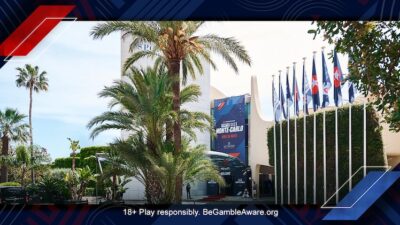At each and every poker tournament, there’s one question that vexes players, commentators, media, dealers and floor staff alike: When will this thing end?
For 90 per cent of the interested parties, the preoccupation is purely selfish. We–I mean, they–are concerned primarily with getting on the drink. But for tournament officials, the question is genuinely business critical, and integral to the smooth management of the event.
Trying to get a poker festival properly staffed requires at least a ballpark idea of how long people will have to work. You have to book a tournament room and security personnel, as well as a bunch of dealers. You also have to make sure they get at least 45 minutes sleep per night.
For this reason, if you want to know how long a day of tournament poker will last, the man to ask is Mike Ward. He’s the tournament director at the PCA, charged not only with planning this 39-event monster but then directing operations on the floor. He needs to be able to tell everyone from senior management through to the janitorial staff how long the days are planned to be.
But when you need, for instance, to trim a returning Day 2 field of 37 Super High Rollers to a final table of eight, you might think you’re looking at the most imprecise piece of science since a ninth grader put a pulled tooth in a cup of Coca Cola and tried to learn about dental hygiene.
Poker is full of variance, right? How could you possibly know how the game is going to play out?
Well, you’d be surprised how accurate Ward can be.
Before a card was dealt this morning, Ward told all concerned that we would be done in eight or nine levels today. He could, actually, have told you that on the week before anyone even got to Atlantis. Or the week before that. Ward has been in the directing game for 21 years and estimates he has presided over tens of thousands of poker tournaments, from low-limit comps at Foxwoods, Connecticut, to $100,000 Super High Rollers in the Bahamas, and just about everything in between.
Premises change, players change, stacks and structures change. But if you know how all these factors combine during every tournament, you can predict with a good degree of confidence how long things are likely to last.
“You take the big blind and you times it by 35 for this particular game,” Ward said, preparing to reveal his not-so-secret formula for calculating the length of tournaments. In short, the key factors are chips in play, the current level and what tends to be the average stack in terms of big blinds.
With the exception of the very beginning and the very end of a tournament, the number of big blinds in an average stack tends to be remarkably steady. In the Super High Roller events, despite starting stacks of 250,000 chips, the players are likely sitting with an average of 35 big blinds at all times.
This changes from tournament to tournament, with a UKIPT, for instance, having something like 40 and an EPT up to 60. But once you know this number (and there are people who record this kind of thing), you can then make a pretty simple calculation.
“Let’s just say the big blind is 10,000,” Ward said. “The big blind times 35 is 350,000. Then you divide the total number of chips in play by 350,000 and that tells me roughly how many players will be in the tournament at the beginning of that level with that big blind.”
Level 15 at the PCA Super High Roller, for instance, has a big blind of 24,000. So 24,000 multiplied by 35 is 840,000. The starting stack here was 250,000 chips and there were 56 entries, so the total chips in play is 250,000 * 56 = 1.4m.
The next stage is to divide 1.4 million by 840,000, which gives us 16. There were, in fact, 14 players remaining at the start of the level, which is well inside the margin of error.
“The more times you do something, the more you figure it out, of course,” Ward said. “In essence what the formula basically tells you, which is true for most things in life, is that whatever your supply is, it can only feed so many people.”
The structure sheets for tournaments like this are all published in advance, and so when the formula would say there should be only two players left, we would be entering the heads up phase and nearing the tournament’s end. Ward has this all programmed into an Excel spreadsheet and can get his estimation at the touch of a button.
In this instance, we are likely to hit our final table in Level 17, because by the time we get to Level 18, the formula has us at a round eight. (Big blind in Level 18 is 50,000. That multiplied by 35 is 1,750,000. Then 1.4m / 1,750,000 = 8.) Even if we ever get slightly ahead, or lag slightly behind schedule, things tend to catch up in the end.
(There’s also the obvious comparison to be made with previous tournaments of a similar structure. Last year, we reached eight players in level 17 and the tournament finished in Level 24. With almost the exact same number of players, there’s no reason to think it’ll be different this year.)
“It’s also to do with the skill level,” Ward added. “Something like this High Roller is going to be a little bit different than your run-of-the-mill tournament because with a little higher skill level, sometimes it can be done faster. Players are more aggressive and they do things that others don’t do.”
Neil Johnson, the PokerStars Live Events Specialist, agrees. He said: “It depends on the names of the players. If there’s a number of known (ie, professional) players who want first (place), the action will be pushed.”
Johnson said that in the whole of Season 9 of the EPT, for instance, the bubble burst in Level 16. People would regularly ask when he estimated we would make the money, and he’d be able to answer, “Day three, level two. Always.”
The Main Event of the PCA begins tomorrow, and we will put Ward’s theories to practice throughout.
Follow hand-by-hand coverage of the Super High Roller event on the dedicated $100,000 Super High Roller page. Also watch the action live on PCA Live.
Back to Top






